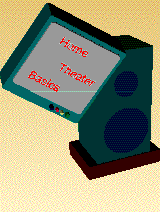What your customers need... and how you can sell it to them.

In a traditional cinema the speakers are located behind the theater screen , which is finely perforated making it acoustically transparent. There are loudspeakers located behind the right, left and center of the theater screen while woofers are located against the wall for low bass impact. The rear channels are located along the sides. The result is evenly distributed sound across the entire theater. Rear channels are necessary in a theater since the volume of the room is much larger than that found in the typical home and even most larger homes. The setup of a home theater very closely resembles the arrangement of the typical movie cinema. As a matter of fact, some individuals go as far as to set aside a separate room in the house for the home theater and even decorate the room as if it were a theater! Although this can be done and have dramatic effects, it is not necessary to do this in order to enjoy the benefits of home theater.
CONSIDERATION #1 - THE SCREEN SIZE: Many retailers insist that a home theater must be centered around a rear projection monitor in order to create a good visual effect. That is simply not necessary. As a matter of fact, many impressive home theaters are centered around a 35" direct view TV and some use a 27".
I ask you, what makes a better car? Should engineers carefully match the horsepower to the vehicle size and weight, or do they simply put in the largest engine that will physically fit? Most will agree that the best car is the one engineered to be the best car. Those that agree with the latter analogy, consider this, many Formula one vehicles are faster than your car and have smaller displacement engines!
Better home theaters are those designed with an understanding of the room size and decor. If the room is visually comfortable with a 35" TV and crowded with a 50" projection, then the 35" is the best choice.
EVALUATE THE VIDEO SOURCE: Your customer should consider what type of video source they plan to use most of the time. The two primary types of video playback devices are VHS hi-fi videotape, and laser disc players. Both sources have distinct advantages. While the laser disc is not a recording format, meaning the customer cannot record his/her own material on this format, the picture quality is superior to VHS and is more permanent. The VHS format however, being a magnetically recorded signal is subject to all of the problems associated with magnetic tape. These being, wear and tear, image deterioration and cassette transport defects (VHS cassette housings are not totally reliable).
CONSIDER THE CABINET: The third consideration is the most complicated and confusing for your customers. That is the dilemma of where to put the speakers and finally where to house all of the equipment associated with the typical Home Theater. The home theater will in most cases become the showpiece of the home. The cabinet must be of furniture grade and also address the needs of the home theater enthusiast. There are several products on the market now that make setting up a home theater easier for the customer to integrate into the home as well as making the category much easier to merchandise. Several manufacturers of entertainment furniture have made provisions for speakers as well as ample room for electronics. They range from those with compartments with cloth covered doors for the speakers to products which market fully engineered solutions to the problem of loudspeaker choice, and placement by building in high quality speaker systems with amplification to drive them into the design of the cabinet. A common problem in the past has been how to match the center channel speaker to the left and right front channels of a Pro Logic system. Common sense indicates that you would simply buy an additional speaker identical to the left and right. Most manufacturers sold speakers in pairs and thus this was difficult. However the popularity of Pro Logic has forced manufacturers to consider this as well as designing speakers to match their left and right channels that have a low profile allowing them to be placed on top of or below the television. A home theater must provide the impact of the cinema by providing the thundering low-end present in the majority of motion picture soundtracks now available. This is accomplished using a subwoofer. The placement of this unit has presented a problem for many consumers. Subwoofers can be built into the cabinet, but the cabinet must be engineered to withstand the sound pressure levels of this type of device. Alternatively, subwoofers can be placed under a table or even in a corner closet. They need not be within eyesight.
Consumer electronics retailers offer very little furniture for housing home theater systems. Most sell "ready to assemble" cabinets of mediocre quality. Serious home theater customers will not be satisfied in these offerings. This is the main reason that many people are not happy with the home theater systems they buy in the consumer electronics market. They soon discover that they have invested a significant amount of money in a system they "have to live with" as opposed to a "system that lives with them". You can make the difference and offer the customer the same expertise in the electronics they will experience by shopping the consumer electronics market retailer. But first, lets work on keeping the home theater customer in your store.
In the next issue we'll look at some of the tried and proven methods of merchandising and selling home theater in the furniture trade.